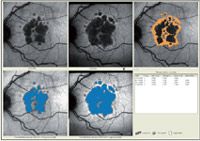Article
Software tracks geographic atrophy
Author(s):
Ophthalmologists using a proprietary confocal scanning laser ophthalmoscope with a fundus autofluorescence module can now quantify and track progression of geographic atrophy over time, thanks to the release of new software.
Bonn, Germany-Ophthalmologists using a proprietary confocal scanning laser ophthalmoscope (cSLO) with a fundus autofluorescence (FAF) module (Spectralis with BluePeak, Heidelberg Engineering) can now quantify and track progression of geographic atrophy over time, thanks to the release of new software (V5.4 with RegionFinder).

Dr. Holz has been a pioneer in developing FAF imaging as a diagnostic technique.

"Having been involved in the initial validation testing,we now look forward to feedback from other centers that will be able to use the new software in routine patient care and research," he said.
The new software is able to perform progression analysis using FAF images captured previously with the cSLO platform. Enlargement of the atrophic areas between serially acquired images is reported in units of mm2.
"We know from AREDS and other natural history studies, including our own, that geographic atrophy spreads continuously in a linear fashion," he said. "The mean progression rate is about 1.5 to 1.6 mm2 per year, and while there is high interindividual variation, the increase in size does not appear to taper off over time.
"Due to the steady nature of its increase, measurement of change in geographic atrophy size is a useful parameter for investigating the effect of potential therapeutic interventions, and it has been accepted by the FDA as an endpoint in clinical trials for dry AMD," Dr. Holz said.
In addition to its value for identifying and measuring progression in geographic atrophy area, FAF images are also being used to identify and describe abnormal patterns in the retina surrounding the atrophic patches. It has been shown that such patterns have prognostic relevance for predicting disease progression in patients with advanced dry AMD, Dr. Holz said.
Spectral-domain optical coherence tomography (SD-OCT) can also be used to quantify and determine progression of geographic atrophy,and SD-OCT gives additional information on morphologic alterations of the neurosensory retina compared with cSLO. However, the lateral resolution with SD-OCT is currently poorer than for the cSLO images, Dr. Holz noted.
Customers with installed cSLO platforms with the FAF module will receive the software upgrade at no charge.

FYI
Frank Holz, MD
E-mail: Frank.Holz@ukb.uni-bonn.de
Dr. Holz is a consultant for Carl Zeiss Meditec, Heidelberg Engineering, and Optos.
Newsletter
Don’t miss out—get Ophthalmology Times updates on the latest clinical advancements and expert interviews, straight to your inbox.





